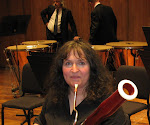Yesterday one of the performances of the Columbus Symphony's Sierra, Beethoven and Brahms program from this past weekend was uploaded onto InstantEncore where it is now streaming:
http://www.instantencore.com/music/details.aspx?PId=5054984
I learn a lot from listening to these streams. In the past it was frustratingly impossible for musicians to obtain recordings of our concerts, but now our recordings are streaming on the internet shortly following each concert. For those of us in the woodwind, brass and percussion sections especially, it's great to have this resource.
While listening to the second movement of the Brahms Symphony No. 2, I realized that, in my earlier post pertaining to this concert, I had forgotten to point out one of the most important details of this movement. Three measures after A, the 1st bassoon starts to tag along with the 1st horn player in his/her solo:
This is tricky. The goal is for the bassoon not to be noticed. It's a HORN solo! The first time I played this when I was a novice in the Columbus Symphony, I thought that the bassoon should be heard in that passage- I considered it a horn and bassoon soli. The polite principal horn player never said anything, but I can just imagine what that seasoned veteran thought!
Since then I've grown up a bit, and I now recognize the greater goal of blending perfectly with another instrument. To the best of my knowledge, the bassoon is the quietest instrument in the orchestra, the one with the smallest dynamic range. And because we can't match the projection power of any other instrument, whenever we have a soli in unison, I believe that our wisest approach is to defer to the other instrument, not trying to overpower or compete, but instead aiming to blend in and match intonation.
Fortunately, our principal horn player has good intonation so that pitch placement is not a guessing game. I also marked his breaths in my part so that I would not be holding over any notes longer than he did. I never asserted the bassoon sound, that is, not until I was on my own, branching off from the horn solo beginning on the 2nd half of the 3rd beat of measure 24.
Of course, I played without vibrato until I branched off on my own. The horn plays without vibrato, and I wanted to match. Also, vibrato draws attention, and that's what I was trying not to do.
When I listened to this passage on the stream, I was pleased. The bassoon was inaudible! (And I really was playing....)
First Sunday of Advent
-
Gabriel’s Message (Basque Christmas folk carol) Arr. Jim Clements VOCES 8
From the YouTube page: Tickets to watch VOCES8’s LIVE From London Christmas
festi...
1 day ago







4 comments:
I heard (or barely heard) that beautiful blend during the concert, and I was impressed.
Thank you, DT. And by the way, you are very easy to blend with also- your stellar intonation is a big part of the reason.
Betsy
I am so glad I get to hear the things you're talking about on the feeds! (Even if it does take me 3 weeks to listen)
Dear TB,
I'm thrilled that you're that interested! (Even if it does take you 3 weeks to listen...)
Betsy
Post a Comment